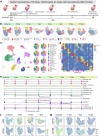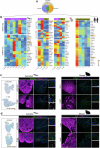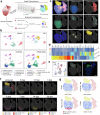An organ-wide spatiotemporal transcriptomic and cellular atlas of the regenerating zebrafish heart
- PMID: 40253397
- PMCID: PMC12009352
- DOI: 10.1038/s41467-025-59070-0
An organ-wide spatiotemporal transcriptomic and cellular atlas of the regenerating zebrafish heart
Abstract
Adult zebrafish robustly regenerate injured hearts through a complex orchestration of molecular and cellular activities. However, this remarkable process, which is largely non-existent in humans, remains incompletely understood. Here, we utilize integrated spatial transcriptomics (Stereo-seq) and single-cell RNA-sequencing (scRNA-seq) to generate a spatially-resolved molecular and cellular atlas of regenerating zebrafish heart across eight stages. We characterize the cascade of cardiomyocyte cell states responsible for producing regenerated myocardium and explore a potential role for tpm4a in cardiomyocyte re-differentiation. Moreover, we uncover the activation of ifrd1 and atp6ap2 genes as a unique feature of regenerative hearts. Lastly, we reconstruct a 4D "virtual regenerating heart" comprising 569,896 cells/spots derived from 36 scRNA-seq libraries and 224 Stereo-seq slices. Our comprehensive atlas serves as a valuable resource to the cardiovascular and regeneration scientific communities and their ongoing efforts to understand the molecular and cellular mechanisms underlying vertebrate heart regeneration.
© 2025. The Author(s).
Conflict of interest statement
Competing interests: The authors declare no competing interests.
Figures





References
MeSH terms
Substances
LinkOut - more resources
Full Text Sources

